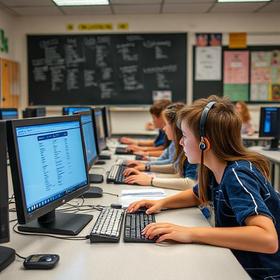Serving 613 students in grades 3-6, Kingston Intermediate ranks in the top 50% of all schools in Massachusetts for overall test scores (math proficiency is top 50%, and reading proficiency is top 50%).
The percentage of students achieving proficiency in math is 49% (which is higher than the Massachusetts state average of 42%). The percentage of students achieving proficiency in reading/language arts is 45% (which is higher than the Massachusetts state average of 44%).
The student-teacher ratio of 15:1 is higher than the Massachusetts state level of 12:1.
Minority enrollment is 10% of the student body (majority Hispanic), which is lower than the Massachusetts state average of 47% (majority Hispanic).
Quick Facts (2025-26)
- Grades: 3-6
- Enrollment: 613 students
- Student-Teacher Ratio: 15:1
- Minority Enrollment: 10%
- Overall Testing Rank: Top 50% in MA
- Math Proficiency: 49% (Top 50%)
- Reading Proficiency: 45% (Top 50%)
- Science Proficiency: 60-64% (Top 30%)
- Source: National Center for Education Statistics (NCES), MA Dept. of Education
School Overview
Kingston Intermediate's student population of 613 students has stayed relatively flat over five school years.
The teacher population of 42 teachers has stayed relatively flat over five school years.
Grades Offered
Grades 3-6
(Supplemental Virtual)
(Supplemental Virtual)
Total Students
613 students
Gender %
Total Classroom Teachers
42 teachers
School Calendar
School Rankings
Kingston Intermediate ranks within the top 50% of all 1,626 schools in Massachusetts (based off of combined math and reading proficiency testing data).
The diversity score of Kingston Intermediate is 0.19, which is less than the diversity score at state average of 0.65. The school's diversity has stayed relatively flat over five school years.
Overall Testing Rank
#729 out of 1626 schools
(Top 50%)
(Top 50%)
Math Test Scores (% Proficient)
49%
42%
Reading/Language Arts Test Scores (% Proficient)
45%
44%
Science Test Scores (% Proficient)
60-64%
44%
Student-Teacher Ratio
15:1
12:1
American Indian
n/a
n/a
Asian
1%
7%
Hispanic
5%
25%
Black
2%
10%
White
90%
53%
Hawaiian
n/a
n/a
Two or more races
2%
5%
All Ethnic Groups
Participates in the National School Lunch Program (NSLP)
Yes
Eligible for Free Lunch
16%
35%
Eligible for Reduced Lunch
2%
4%
School Statewide Testing
School District Name
Source: National Center for Education Statistics (NCES), MA Dept. of Education
Profile last updated: 02/09/2025
Frequently Asked Questions
What is Kingston Intermediate's ranking?
Kingston Intermediate is ranked #729 out of 1,626 schools, which ranks it among the top 50% of public schools in Massachusetts.
What percent of students have achieved state testing proficiency in math and reading?
49% of students have achieved math proficiency (compared to the 42% MA state average), while 45% of students have achieved reading proficiency (compared to the 44% MA state average).
How many students attend Kingston Intermediate?
613 students attend Kingston Intermediate.
What is the racial composition of the student body?
90% of Kingston Intermediate students are White, 5% of students are Hispanic, 2% of students are Black, 2% of students are Two or more races, and 1% of students are Asian.
What is the student-teacher ratio of Kingston Intermediate?
Kingston Intermediate has a student ration of 15:1, which is higher than the Massachusetts state average of 12:1.
What grades does Kingston Intermediate offer ?
Kingston Intermediate offers enrollment in grades 3-6 (Supplemental Virtual).
What school district is Kingston Intermediate part of?
Kingston Intermediate is part of Kingston School District.
School Reviews
Review Kingston Intermediate. Reviews should be a few sentences in length. Please include any comments on:
- Quality of academic programs, teachers, and facilities
- Availability of music, art, sports and other extracurricular activities
Recent Articles

Cybersecurity in U.S. Public Schools 2025: Risks, Policies & Protection
Explore the 2025 state of cybersecurity in U.S. public schools, updated data, expert insights, policy moves, and how schools and families can stay safe.

The Rise of STEM in Public Schools: 2025 Update
Explore how STEM is transforming U.S. public schools in 2025—trends, policies, programs, and what parents and educators should know.

How Public Schools Support Mental Health in 2025
Explore how U.S. public schools are supporting student mental health in 2025—programs, results, challenges and strategies for educators, parents and policymakers.









